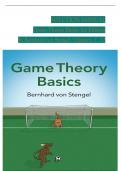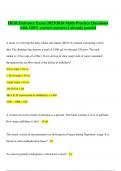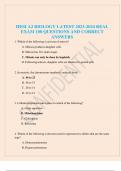SOLUTION MANUAL
Game Theory Basics 1st Edition
By Bernhard von Stengel. Chapters 1 - 12
1
,TABLE OF CONTENTS OP OP OP
1 - Nim and Combinatorial Games
OP OP OP OP OP
2 - Congestion Games
OP OP OP
3 - Games in Strategic Form
OP OP OP OP OP
4 - Game Trees with Perfect Information
OP OP OP OP OP OP
5 - Expected Utility
OP OP OP
6 - Mixed Equilibrium
OP OP OP
7 - Brouwer’s Fixed-Point Theorem
OP OP OP OP
8 - Zero-Sum Games
OP OP OP
9 - Geometry of Equilibria in Bimatrix Games
OP OP OP OP OP OP OP
10 - Game Trees with Imperfect Information
OP OP OP OP OP OP
11 - Bargaining
OP OP
12 - Correlated Equilibrium
OP OP OP
2
,Game Theory Basics OP OP
Solutions to Exercises O P O P
© Bernhard von Stengel 2022
O P OP OP OP
Solution to Exercise 1.1 OP OP OP
(a) Let ≤ be defined by (1.7). To show that ≤ is transitive, consider x, y, z with x ≤ y and y ≤ z.
OP OP OP OP OP O P OP OP OP OP OP OP OP OP OP OP OP O P OP OP OP OP OP OP
If x = y then x ≤ z, and if y = z then also x ≤ z. So the only case left is x < y and y < z, w
OP OP OP OP OP OP OP OP OP OP OP OP OP OP OP OP OP OP OP OP OP OP OP OP OP OP OP OP OP OP OP
hich implies x < z because < is transitive, and hence x ≤ z.
OP OP OP OP OP OP OP OP OP OP OP OP OP
Clearly, ≤ is reflexive because x = x and therefore x ≤ x.
OP OP OP OP OP OP OP OP OP OP OP OP
To show that ≤ is antisymmetric, consider x and y with x
OP OP y≤and y x.≤If we had x ≠
OPOPOPOPOP OP OP OP OP OP OP OP OPOPOPOPOP OP OP OPOPOPOPOP OP OP OP OP OP O
y then x < y and y < x, and by transitivity x < x which contradicts (1.38). Hence x = y, as
P OP OP OP OP OP OP OP OP OP OP OP OP OP OP OP OP OP OP OP OP OP OP OP
required. This shows that ≤ is a partial order.
OP OP OP OP OP OP OP OP
Finally, we show (1.6), so we have to show that x < y implies x y and≤x ≠ y and vice vers
OP OP OP OP OP OP OP OP OP OP OP OP OP OP OPOPOP OP OP OP OP OP OP OP
a. Let x < y, which implies x y by (1.7). If we≤had x = y then x < x, contradicting (1.38), so
OP OP OP OP OP OP OP OP OP OP OP OP OP OP OP OP OP OP OP OP OP OP OP OP
we also have x ≠ y. Conversely, x y and x ≠ y imply by (1.7)x ≤< y or x = y where the seco
OP OP OP OP OP OP OP OPOPO P OP OP OP OP OP OP OP P
O OP OP OP OP OP OP OP OP OP
nd case is excluded, hence x < y, as required.
OP OP OP OP OP OP OP OP OP
(b) Consider a partial order and ≤ assume (1.6) as a definition of <. To show that < is transitiv
OP OP OP OP OP OP OP OP OP OP OP OP OP OP OP OP OP
e, suppose x < y, that is, x y and x ≠ y,≤and y < z, that is, y z and y ≠ z. Because
OP OP OP
≤
OP is trans
OP OP OP OP OP OP OP OP OP OP OP OP OP OP OP OP OP OP OP OP OP OPOPOPOP OP
itive, x ≤z. If we had x = z≤then x
OP y and y
OPOPOPOP x and hence
≤ OP x = y by
≤ antisymmetry
OP of OP OP OP OP OP OP OPOPOPOPOP OP OP OPOPOPOPOP OP OP OP OP OP OP OP OP OPOPOPO
, which contradicts x ≠ y, so we have x z and x ≠ z, that is,x < z by (1.6), as required.
≤ ≤
P OP OP OP OP OP OP OP OP OP OPOPOPO P OP OP OP OP OP OP P
O OP OP OP OP OP OP
Also, < is irreflexive, because x < x would by definition mean x x and≤x ≠ x, but the latte
OP OP OP OP OP OP OP OP OP OP OP OP OPOPOP OP OP OP OP OP OP OP
r is not true.
OP OP OP
Finally, we show (1.7), so we have to show that x ≤ y implies x < y or x = y and vice vers
OP OP OP OP OP OP OP OP OP OP O P OP OP OP OP OP OP OP OP OP OP OP OP
a, given that < is defined by (1.6). Let x ≤ y. Then if x = y, we are done, otherwise x ≠ y a
OP OP OP OP OP OP OP OP OP OP OP OP OP OP OP OP OP OP OP OP OP OP OP OP
nd then by definition x < y. Hence, x ≤ y implies x < y or x = y. Conversely, suppose x <
OP OP OP OP OP OP OP OP OP OP OP OP OP OP OP OP OP OP OP OP OP O P O
Py or x = y. If x < y then x ≤ y by (1.6), and if x = y then x ≤ y because ≤ is reflexive.
OP OP OP OP O P OP O P O P OP OP O P OP OP OP OP OP OP OP OP OP OP OP OP OP OP OP OP O
PThis completes the proof.
OP OP OP
Solution to Exercise 1.2 OP OP OP
(a) In analysing the games of three Nim heaps where one heap has size one, we first lookat so
OP OP OP OP OP OP OP OP OP OP OP OP OP OP OP OP PO OP
me examples, and then use mathematical induction to prove what we conjecture to be the losin
OP OP OP OP OP OP OP OP OP OP OP OP OP OP OP
g positions. A losing position is one where every move is to a winning position, because th
OP OP OP OP OP OP OP OP OP OP OP OP OP OP OP OP
en the opponent will win. The point of this exercise is to formulate a precise statement to b
OP OP OP OP O P OP OP OP OP OP OP OP OP OP OP OP OP
e proved, and then to prove it.
OP OP OP OP OP OP
First, if there are only two heaps recall that they are losing if and only if the heaps are of
OP OP OP OP OP OP OP OP OP OP OP OP OP OP OP OP OP OP OP
equal size. If they are of unequal size, then the winning move is to reduce thelarger heap
OP OP OP OP OP OP OP OP OP OP OP OP OP OP OP OP P
O OP O
so that both heaps have equal size.
P OP OP OP OP OP OP
3
, Consider three heaps of sizes 1, m, n, where 1 OP m
≤ ≤ n. We observe the following: 1, 1,
OP OP OP OP OP OP OP OP OPOPOPOPOP OPOPOPOPOP OP OP OP OP OP OP
m is winning, by moving to 1, 1, 0. Similarly, 1, m, m is winning, by moving to 0, m, m.
OP OP OP OP OP OP OP OP OP OP OP OP OP OP OP OP OP OP OP OP OP OP
Next, 1, 2, 3 is losing (observed earlier in the lecture), and hence 1, 2, n for n 4 is winnin
OP OP OP OP OP OP OP OP OP OP OP OP OP OP OP OP OP OP OP OP
g. 1, 3, n is winning for any n 3 by moving to 1, 3, 2. For 1, 4, 5, reducing any heap pro
≥ ≥
OP OP OP OP OP OP OP OP OP OP OP OP OP OP OP OP OP OP OP OP OP OP OP
duces a winning position, so this is losing.
OP OP OP OP OP OP OP
The general pattern for the losing positions thus seems to be: 1, m, m 1, for +even number
OP OP OP OP OP OP OP OP OP OP OP OP OP OP OP OP OP
s m. This includes also the case m = 0, which we can take as the base case foran induction.
OP OP OP OP OP OP OP OP OP OP OP OP OP OP OP OP OP OP P
O OP O
PWe now proceed to prove this formally.
OP OP OP OP OP OP
First we show that if the positions of the form 1, m, n with m
OP OP n≤are losing when m is
OP OP OP OP OP OP OP OP OP OP OP OP OPOPOPOPOPOP OP OP OP OP OP OP
even and n = m 1, then+these are the only losing positions because any other position 1, m,
OP OP OP OP OP OP OP OP OP OP OP OP OP OP OP OP OP OP
n with m
OP O P n is winning.
≤ Namely, if m = n then a winning move from1, m, m is to 0,
OP O P O P O P OP O P OP OP O P OP O P OP OP OP OP PO OP OP OP OP OP OP
m, m, so we can assume m < n. If m is even then n > m 1 (otherwise we would be in the
+
OP OP OP OP OP OP OP OP O P OP OP OP OP OP OP OP O P O P OP OP OP OP OP OP O
position 1, m, m 1) and so the winning move is to 1, m, m 1. If m is odd then the w
inning move is to 1, m, m 1, the same as+position 1, m 1, m (this would also be a winning
+ mo
P OP OP OP O P O P OP OP OP OP OP OP OP OP OP OP O P O P OP OP OP OP OP OP OP
OP OP OP OP OP OP OP OP OP OP OP OP OP OP OP OP OP OP OP OP OP OP
ve from 1, m, m so there the winning move is not
OP OP
– unique).
OP OP
−
OP OP OP OP OP OP OP OP
Second, we show that any move from 1, m, m + 1 with even m is to a winning position,using
OP OP OP OP OP OP OP OP OP OP OP OP OP OP OP OP OP OP OP PO OP
as inductive hypothesis that 1, mJ, mJ + 1 for even mJ and mJ < m is a losing position. The
OP OP OP OP OP OP OP OP OP OP OP OP OP OP OP OP OP OP OP OP OP
move to 0, m, m + 1 produces a winning position with counter-
OP OP OP OP OP OP OP OP OP OP OP OP
move to 0, m, m. A move to 1, mJ, m + 1 for mJ < m is to a winning position with the counter
OP OP OP OP OP OP OP OP OP OP OP OP OP OP OP OP OP OP OP OP OP OP OP OP
-
move to 1, mJ, mJ + 1 if mJ is even and to 1, mJ, mJ − 1 if mJ is odd. A move to 1, m, m is
OP OP OP OP OP OP OP OP OP OP OP OP OP OP OP OP OP OP OP OP OP OP OP OP OP OP OP OP OP
to a winning position with counter-
OP OP OP OP OP
move to 0, m, m. A move to 1, m, mJ with mJ < m is also to a winning position with the cou
OP OP OP OP OP OP OP OP OP OP OP O P OP O P OP OP OP OP OP OP OP OP OP
nter-
move to 1, mJ − 1, mJ +if mJ is odd, and to 1, mJ
OP OP 1, mJ if mJ is+even (in which case mJ
OP OP OP 1< OP OP O P OP OP OP OP OP OP O P OP OP OP OP OP OP OP OP OP O P OP
OPm because m is even). This concludes the induction proof.
OP OP OP OP OP OP OP OP OP
This result is in agreement with the theorem on Nim heap sizes represented as sums of powers
OP OP OP OP OP OP OP OP OP OP OP OP OP OP OP OP
of 2: 1
OP OP
∗m +∗ n+∗is losing if and only if, except for 20, the powers of 2 making upm and n
O P O P O P O P
O P
O P OP OP OP OP OP OP OP OP OP OP OP OP OP OP OP PO OP OP OP
come in pairs. So these must be the same powers of 2, except for 1 = 20, which occurs in only
OP OP OP OP OP OP OP OP OP OP OP OP OP OP OP OP OP OP OP OP
m or n, where we have assumed that n is the larger number, so 1 appearsin the representatio
OP OP OP OP OP OP OP OP OP OP OP OP OP OP OP OP PO OP OP
n of n: We have m = 2a 2b 2c OPOPOPOPOPOP OPOPOPOPOPOP
+ + + ···
OP OP O P OP OP OP OP
OP OP OP
for a > b > c > 1
a · ·+· ≥ b + + ·c · · + +
OP O P OP O P OP O P OPOPOPOPOPOPOPO P
,so m is even, and, with the same a, b, c, . . ., n = 2 2 2
OP O P O P OP OP OP OP
O P O P O P O P O P O P
P
O OP OP OP OP OP OP OP OP OP OP OP OP OP OP O P OP
1 = m 1. Then OP OP OPOPOPO P O P
∗1 + ∗ m+ ∗ ≡n ∗
O P OP
0. The following is an example using the bit representation where
OPOPOPOPOPO P OPOPOPOPO P
OP OP
OPOPOPOPOPO P O P OP OP OP OP OP OP OP OP OP
m = 12 (which determines the bit pattern 1100, which of course depends on m):
OP OP OP OP OP OP OP OP OP OP OP OP OP OP
1 = 0001
12 = 1100
13 = 1101
Nim-sum 0 = 0000
(b) We use (a). Clearly, 1, 2, 3 is losing as shown in (1.2), and because the Nim-
OP OP OP OP OP OP OP OP OP OP OP OP OP OP OP OP
sum of the binary representations 01, 10, 11 is 00. Examples show that any other positio
OP OP OP OP OP OP OP OP OP OP OP OP OP OP OP
n iswinning. The three numbers are n, n + 1, n + 2. If n is even then reducing the heap of
OP P
O OP OP OP OP OP OP O P OP O P O P OP OP OP OP OP OP OP OP OP OP
size n 2 to 1 creates the position n, n 1, 1 which is losing as shown in (a). If n is odd, t
+ +
OP OP OP OP OP OP OP OP OP O P OP OP OP OP OP OP OP OP OP OP OP OP OP
hen n 1 is even and n 2 = n 1 1 so by the same argument, a winning move is to
+ +
OP O P OP OP OP OP OPOPOP OP O P OPOPOP OPOPOP OP OP OP OP OP OP OP OP OP OP OP
reduce the Nim heap of size n to 1 (which only works if n > 1).
( + )+
OP OP OP OP OP OP OP OP OP OP OP OP OP OP OP
O P O P OP
4






